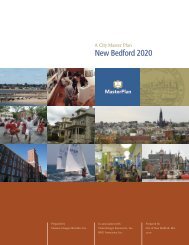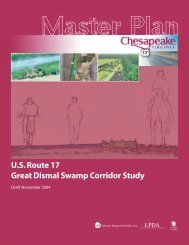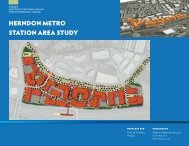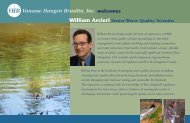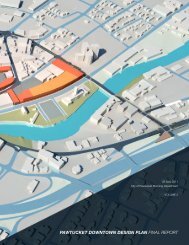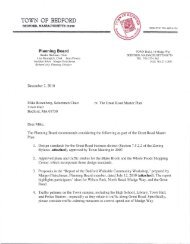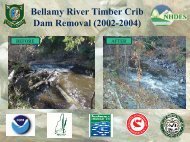Final Report - VHB.com
Final Report - VHB.com
Final Report - VHB.com
You also want an ePaper? Increase the reach of your titles
YUMPU automatically turns print PDFs into web optimized ePapers that Google loves.
Environmental Impacts<br />
Environmental Resources<br />
Both alignments avoid impacts to wetlands, streams, and rivers, and no hazardousmaterial<br />
sites were found in the footprint of the proposed rail alignments. Neither<br />
alignment requires a substantial amount of new pavement, which would limit the<br />
potential for future stormwater impacts. However, the open fields at the northern<br />
end of the NASB runways contain habitat for two protected bird species that depend<br />
on open grasslands: the state-threatened upland sandpiper and state-endangered<br />
grasshopper sparrow. Understanding the potential impacts to these species is an<br />
important issue if Strategy 3 is selected for advancement. Because the western<br />
options affect more of this grassland habitat, it is expected that Options 1 and 1A<br />
would have a greater effect on these species. Additionally, the western options<br />
would have more potential impact to the sand and gravel aquifer found in this area.<br />
Right-of-Way<br />
The western options (Options 1 and 1A) require slightly more ROW acquisition than<br />
the eastern options (Options 2 and 2A), estimated at approximately 7 acres or about 6<br />
acres, respectively. Most of this ROW impact would occur to land currently within<br />
the NASB, with some minor strip takings along Bath Road (i.e., State Route 24). For<br />
this reason, the tax-loss implications of this strategy are quite limited because NASB<br />
property has not previously been on the tax rolls. No park or recreation areas would<br />
be affected.<br />
Cultural Resources<br />
No standing structures would be directly affected by either rail-connection option;<br />
therefore, the potential for impacts to historic buildings is very low. However, as<br />
discussed for Strategy 1, previous archeological studies established a number of<br />
historic and prehistoric archeological sites in this area. Additional field surveys of the<br />
area of potential impact would need to be conducted to adequately understand<br />
potential effects to archeological resources that may result from the construction of<br />
the rail connection.<br />
Airspace Obstruction Analysis<br />
Strategy 3 Options 1, 1A, 2, and 2A, which provide direct freight rail-spur access to<br />
the NASB, were examined to determine if they had any impact to the NASB airspace<br />
for Runways 19R and 19L. Options 1 (grade-separated) and 1A (at-grade) are located<br />
approximately 700 feet east of Runway 19 and fall within the controlling airspace<br />
obstruction departure surface. Options 2 (grade-separated) and 2a (at-grade) are<br />
located approximately 0.5 mile farther east of Runway 19L and out of the direct<br />
influence of the NASB runway obstruction departure surface and not subjected to<br />
any further evaluation. Options 1 and 1A were evaluated to identify potential<br />
conflicts in the form of obstructions, hazards to air navigation, and air-service<br />
limitations that may arise from bringing rail service into the airport. Option 1, as<br />
Conclusions 159



